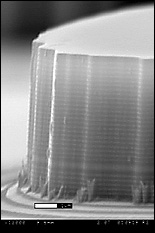Professor Aris Christou
The design and performance of a low threshold selectively oxidized Vertical Cavity Surface Emitting Laser (VCSEL) fabricated for operation at a wavelength of 3.0 μm. was presented in Florence Italy, at the SPIE conference on Defense and Security in September 2007 and then again as late news at Photonics West. The device is based on III-V quaternary semiconductor alloys and is grown by the Molecular Beam Epitaxy technique. The theoretical investigation of the optical properties of the compound semiconductor alloys allowed us to select the optimum materials for highly reflective Bragg mirrors. The unique design integrates a thermoelectric controller and an array of lasers to provide continuous tunability.

[The Laser Mesa. Gas: BCl3, 12.5 sccm, Cl2, 2.5 sccm. Etching rate: 0.32454 μm/min.]
Compound semiconductor-based long wavelength surface emitting lasers are becoming important light sources for large capacity optical communications and optical interconnection systems. Those devices exhibit such advantages as low threshold currents, single mode operation, high coupling efficiencies into optical fiber, and high speed modulation. The development of surface emitting lasers at 3μm has been centered on the investigation of structures and materials for highly reflective Bragg mirrors grown on InP.
Many diatomic molecules (CO, HCl, NO, etc.), as well as triatomic molecules, have absorption bands in the 3-20 μm range. High sensitive chemical sensors rely on the resonant absorption of infrared radiation (3-20 mm) of the gas molecules within a contained optical ring. The work undertaken has resulted in a new combination of standard compound semiconductors resulting in the design, fabrication and performance of a tunable surface emitting laser which can emit within the desired wavelength region of interest for many detection methods. A very comprehensive investigation of the dielectric constants and energy band gaps of quaternary semiconductor alloys have been utilized to optimize the structure of the surface emitting laser, and to achieve improved performance.
The SEL development was funded by the NASA Space LIDAR Technology Center under the UMD-NASA Cooperative agreement.
Related Paper:
A. Christou, C. C. Zhang and M. Linnik. "Tunable Wavelength Surface Quantum Cascade Lasers for Chemical Sensors in the 3-6 μm Spectral Region." Optical Materials in Defence Systems Technology IV, edited by James G. Grote, Francois Kajzar, and Mikael Lindgren. Proceedings of SPIE Vol. 6740, 67400G, (2007).
Top